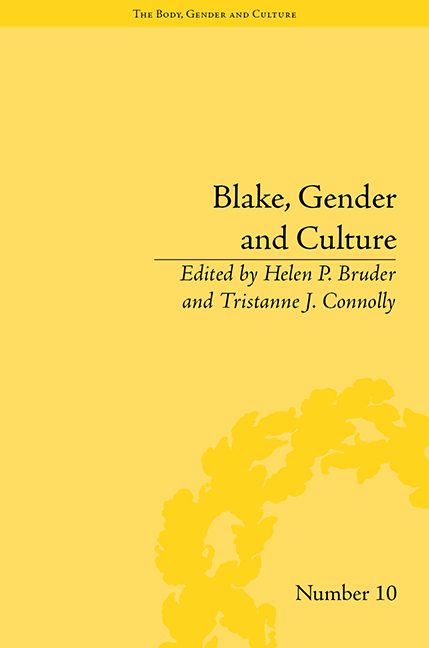Book contents
- Frontmatter
- CONTENTS
- Acknowledgements
- List of Contributors
- List of Figures
- Abbreviations
- Introduction: Naked History Displayed
- 1 ‘Merely a Superior Being’: Blake and the Creations of Eve
- 2 The Last Strumpet: Harlotry and Hermaphroditism in Blake's Rahab
- 3 Sex, Violence and the History of this World: Blake's Illustrations to the Book of Enoch
- 4 Bridal Mysticism and ‘Sifting Time’: The Lost Moravian History of Blake's Family
- 5 ‘A Secret Common to Our Blood’: The Visionary Erotic Heritage of Blake, Thomas Butts and Mary Butts
- 6 Changing the Sexual Garments: The Regeneration of Sexuality in Jerusalem
- 7 Philoprogenitive Blake
- 8 ‘Seeking Flowers to Comfort Her’: Queer Botany in Blake's Visions, Darwin's Loves and Wollstonecraft's Rights of Woman
- 9 ‘Or Wilt Thou Go Ask the Mole?’: (Con)Figuring the Feminine in Blake's Thel
- 10 Gendering the Margins of Gray: Blake, Classical Visual Culture and the Alternative Bodies of Ann Flaxman's Book
- 11 The Virgil Woodcuts Out of Scale: Blake's Gigantic, Masculine Pastoral
- 12 Closet Drama: Gender and Performance in Blake and Joanna Baillie
- Notes
- Works Cited
- Index
11 - The Virgil Woodcuts Out of Scale: Blake's Gigantic, Masculine Pastoral
- Frontmatter
- CONTENTS
- Acknowledgements
- List of Contributors
- List of Figures
- Abbreviations
- Introduction: Naked History Displayed
- 1 ‘Merely a Superior Being’: Blake and the Creations of Eve
- 2 The Last Strumpet: Harlotry and Hermaphroditism in Blake's Rahab
- 3 Sex, Violence and the History of this World: Blake's Illustrations to the Book of Enoch
- 4 Bridal Mysticism and ‘Sifting Time’: The Lost Moravian History of Blake's Family
- 5 ‘A Secret Common to Our Blood’: The Visionary Erotic Heritage of Blake, Thomas Butts and Mary Butts
- 6 Changing the Sexual Garments: The Regeneration of Sexuality in Jerusalem
- 7 Philoprogenitive Blake
- 8 ‘Seeking Flowers to Comfort Her’: Queer Botany in Blake's Visions, Darwin's Loves and Wollstonecraft's Rights of Woman
- 9 ‘Or Wilt Thou Go Ask the Mole?’: (Con)Figuring the Feminine in Blake's Thel
- 10 Gendering the Margins of Gray: Blake, Classical Visual Culture and the Alternative Bodies of Ann Flaxman's Book
- 11 The Virgil Woodcuts Out of Scale: Blake's Gigantic, Masculine Pastoral
- 12 Closet Drama: Gender and Performance in Blake and Joanna Baillie
- Notes
- Works Cited
- Index
Summary
Edmund Burke's sexualized conception of the beautiful and sublime saw these as embodied by smallness and vastness respectively, the former having some kind of limit or frame and the latter being unbounded. This essay discusses these gendered aesthetic categories alongside Blake's illustrations to Robert Thornton's 1821 schoolbook Pastorals of Virgil. This reproduced Virgil's Latin eclogues alongside English imitations and extended commentaries aimed at edifying the schoolboy reader, with a prefatory endorsement from the headmaster of St Paul's School. There were numerous illustrations throughout. Blake's contributions include some portrait engravings; a series of original woodcuts illustrating Ambrose Phillips's ‘Imitation of Eclogue I’ and an intermediary drawing after Poussin's Landscape with Polyphemus to illustrate Virgil's second eclogue.
I examine Thornton's book together with some peripheral texts and images, seeking, in a way, the things it chooses not to reveal – a kind of methodology of lost parts. There is also a logic of castration running through. This starts with the way Pastorals of Virgil uses and reduces Poussin's giant Cyclops. I will then move on to consider evidence of Blake's original intentions for his Virgil series and how Thornton sought to contain it spatially, through the imposition of a frame. Finally I argue that the lost versions of Blake's images defamiliarize scale, confusing giants and boys, birds and stars. For evidence of these lost versions I look at the relief-etched version of part of the Virgil series; those proofs that survive from before the edges of the block were chopped; and one of the drawings Blake made for the three original designs for his series that were engraved anonymously by another hand. Throughout, my exploration of missing images and chopped-off extremities explores the sexualized dynamics of scale and framing in book illustration.
- Type
- Chapter
- Information
- Blake, Gender and Culture , pp. 145 - 164Publisher: Pickering & ChattoFirst published in: 2014



